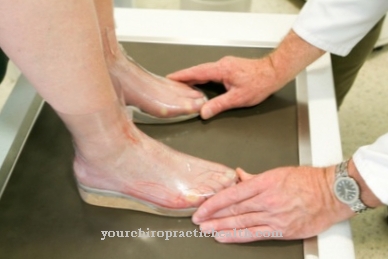The Rydel-Seiffer tuning fork is an (almost) normal tuning fork with the basic frequencies 64 and 128 Hz, the natural C and C vibrations, which differ a little from the concert vibration that is common today, which is based on the concert pitch a with 440 Hz. The Rydel-Seiffer tuning fork is used to diagnose functional impairments of the peripheral nerves as well as to diagnose whether there is a hearing impairment in the middle or inner ear.
What is the Rydel-Seiffer tuning fork?

The name Rydel-Seiffer tuning fork goes back to Adam Rydel and Friedrich Wilhelm Seiffer, who jointly proposed a method for measuring vibration perception using a tuning fork in 1903. Tuning fork and procedure are still an important and first diagnostic procedure for the detection of neuropathy or other problems of the peripheral nervous system. In addition, the Rydel-Seiffer tuning fork can be used to determine in a simple and safe way whether the hearing loss is middle or inner ear hearing loss.
In principle, it is a tuning fork in the basic oscillation c with 128 Hz, whereby two weights (vibration dampers), which are attached to both ends of the prongs, reduce the oscillation by one octave to 64 Hz. Vibration sensitivity measurements are always carried out with dampers attached, i.e. with a vibration frequency of 64 Hz. The dampers have markings and a scale from 1 to 8 on which the vibration intensity can be read off optically. After tearing the tuning fork, the oscillation corresponds to 1 and gradually reaches the value 8 immediately before the oscillation completely dies away.
The use of the Rydel-Seiffer tuning fork is based on the knowledge that in the case of neuropathological impairments, the sense of vibration can serve as the best early indicator. At 64 Hz, the C oscillation does not quite correspond to the concert pitch, the low C oscillation of which oscillates at 65.4 Hz.
Shapes, types & types
All Rydel-Seiffer tuning forks that are offered in specialist shops work on the same principle. These are always tuning forks that vibrate at 128 Hz when the dampers are not attached and one octave lower at 64 Hz when the dampers are screwed on.
All Rydel-Seiffer tuning forks suitable for neuropathological examinations have two triangles each, which create an optical effect from which the respective vibration intensity can be read. The standardized intensity scale ranges from 1 (strong vibration) to 8 (weakest vibration).
The price range for Rydel-Seiffer tuning forks, which are suitable for use in medical diagnostics, is kept within narrow limits. Neuropathological measurements of the peripheral nerves are only ever carried out at the frequency reduced to 64 Hz, while the weights are removed for the examination of the hearing.
Structure & functionality
Rydel-Seiffer tuning forks are very similar in structure to the tuning forks used in music. However, they always have a hard rubber foot which, after tearing the tuning fork, can be placed on certain parts of the body - if possible perpendicular to the skin surface - in order to measure the vibration sensitivity at the corresponding point or on a certain nerve.
The two weights, which can be placed on the two ends of the tuning fork and screwed tight with knurled screws, not only serve the purpose of reducing the oscillation from 128 Hz to 64 Hz, but also enable the respective oscillation intensity to be read off.
To measure the vibration sensitivity, the tuning fork is torn and placed with the foot on the terminal point of the nerve to be examined. If systemic neuropathy is suspected, the foot of the torn tuning fork can be placed on one of the four tarsometatarsal joints that connect the metatarsal and tarsal bones, for example.
The so-called Weber and Rinne tests, both of which are carried out with the dampers removed, i.e. at 128 Hz, are used to examine hearing impairments. When the dampers are removed, the vibration intensity can no longer be read, which is not a problem in the hearing tests, as this is mainly about qualitative effects.
You can find your medication here
➔ Medicines for ear complaints and hearing problemsMedical & health benefits
Vibrations are sensed by the so-called Father Pacini bodies. These are the non-medullary ends of peripheral nerves surrounded by a medullary sheath. The nerve endings are surrounded by lamellae, encapsulated and are found in different densities in the subcutaneous tissue. The Vater-Pacini corpuscles have the highest sensitivity of all mechanoreceptors, so that they also react very sensitively to functional restrictions of the sensitive nerves, for example as a result of the onset of neuropathy.
Neuropathies can arise, for example, from metabolic disorders as a result of diabetes, from a manifest deficiency in vitamin B-12, from neurotoxins, from bacterial inflammation of the nerves or from chronic alcohol abuse.
The detection and rough quantification of such nerve damage can be carried out very inexpensively - and yet accurately - with little effort by tests with the Rydel-Seiffer tuning fork.
During the tests and the subsequent diagnosis, it must be taken into account that the sensation of vibration decreases with increasing age. While younger people should still perceive the lowest level on the Rydel-Seiffer tuning fork (8/8), the decrease in sensitivity to 6/8 in people over 70 is the normal case.
Another possible application concerns the qualitative examination of the hearing in the presence of hearing impairment. Hearing loss can be caused by problems with the outer ear (ear canal and ear drum), the middle ear (ossicles), or the inner ear (cochlea or cochlea).
While damage to the outer ear, such as a clogged ear canal or a defective eardrum, can be diagnosed relatively easily, the distinction is whether there is a problem in the implementation of the received sound via the auditory ossicles to the cochlea or whether the hearing loss is due to the implementation of the mechanical Stimuli based on nervous impulses and the conduction is difficult.
The so-called Weber test and the subsequent Rinne test, both of which are carried out with the Rydel-Seiffer tuning fork without weights (i.e. at 128 Hz), provide certainty as to which ear has internal or middle ear hearing loss.








.jpg)



















